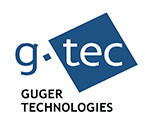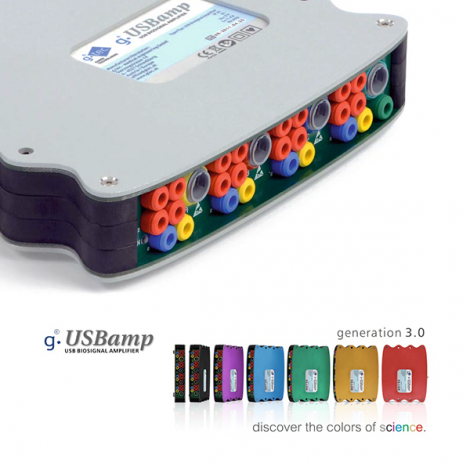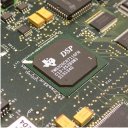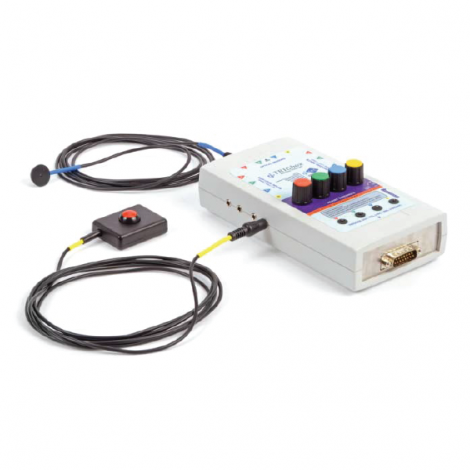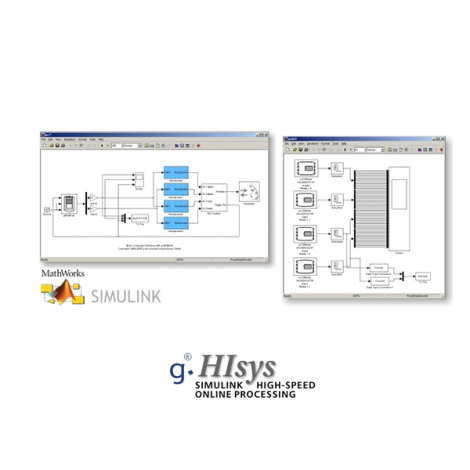g.USBamp RESEARCH is a high-performance and high-accuracy biosignal amplifier for the acquisition and processing of physiological signals. Therefore, you can record physiological activity from the brain, eyes, heart, muscles, and more – including respiration, galvanic skin response, temperature, and many other physiological and physical parameters. Due to its sophisticated technical specifications and the large software environment, this g.USBamp RESEARCH has become a widely used standard for neuropsychological research, neurophysiologcal research, life sciences and biofeedback, neurofeedback and brain-computer interface (BCI) research.
g.USBamp RESEARCH is USB enabled and supports 16 simultaneously sampled biosignal channels at 24 bit resolution. A total of 4 independent grounds guarantee that there is no interference between the recorded signals.
The biosignal amplifier connects easily to the USB socket on your PC/notebook and can immediately be used for data recording. The g.USBamp has an input range of ± 250 mV, which allows recording of DC signals without saturation. Digital inputs and outputs allow the measurement of trigger channels together with the biosignal channels to easily pass analysis results to the outside world. A short-cut input allows users to connect g.USBamp RESEARCH inputs quickly to the ground potential to protect the amplifier against overflows, which may occur in operating rooms with gamma knives or other environments.
g.USBamp RESEARCH is intended to be used for physiological research and experiments only. In other words, this biosignal amplifier is not a medical device to be used for diagnosis, treatment of disease or other medical applications. All features of g.USBamp RESEARCH are freely accessible and configurable.
PRODUCT HIGHLIGHTS
| 16 DC-coupled wide-range input channels per unit, 4 independent grounds, record any type of signal (EEG/ECoG/ECG/EMG/EOG/spikes,…), connect various sensors |
| 24-bit resolution with simultaneous sampling of all channels with up to 38.4 kHz, digital signal filtering and preprocessing, connect via USB 2.0 |
| Internal digital bandpass and notch filters, built-in calibration unit and impedance checking |
| Use g.USBamp biosignal amplifier with all types of active EEG electrodes (g.SCARABEO, g.SAHARA, g.LADYbird, cortiQ electrodes) and g.SENSOR fNIRS |
| Works with passive and with active EEG electrodes, 8 digital trigger inputs/unit, 4 digital outputs/unit |
| Simultaneous TMS/tDCS/fNIRS recording possible |
| g.HIsys Basic/Professional software environment for real-time processing, recommended by BCI2000 & approved under OpenVIBE |
| Use g.HIsys Professional to read and analyze EEG data of multiple g.USBamps with the multi-device toolbox |
| Driver package/API available |
TECHNICAL SPECIFICATIONS
| Weight | 1000 g |
| Size | 197 x 155 x 40 mm |
| Color | Color of choice |
| Sensitivity | 85,7 nV / +/- 250 mV |
| Amplifier type | real DC coupled |
| 16 × ADC | 24 Bit (38.4 kHz internal sampling per channel) |
| 2 x DAC | 12 bit |
| Noise level | < 0,4 µV rms 1-30 Hz |
| Input channels | 16 mono- / 8 bi-polar (per device, software selectable) |
| Input impedance | > 1000 GOhm // 220 pF |
| Input connectors | standard safety connectors and system connectors |
| Applied part | CF |
| Safety class | II |
BCI RACE AT CYBATHLON, SWITZERLAND
The Cybathlon took first place on October 8th, 2016 at the ETH Zurich where people with disabilities competed side by side at the Brain-Computer Interface Race (BCI Race). Pilot Numa Poujouly from École Polytechnique Fédérale de Lausanne (EPFL) in Switzerland won Gold in the BCI Race using his brain activity to control an avatar. The game was called “BrainRunners”, especially developed for the Cybathlon’s BCI Race. Numa used the g.USBamp RESEARCH as am EEG amplifier to compete in this game.
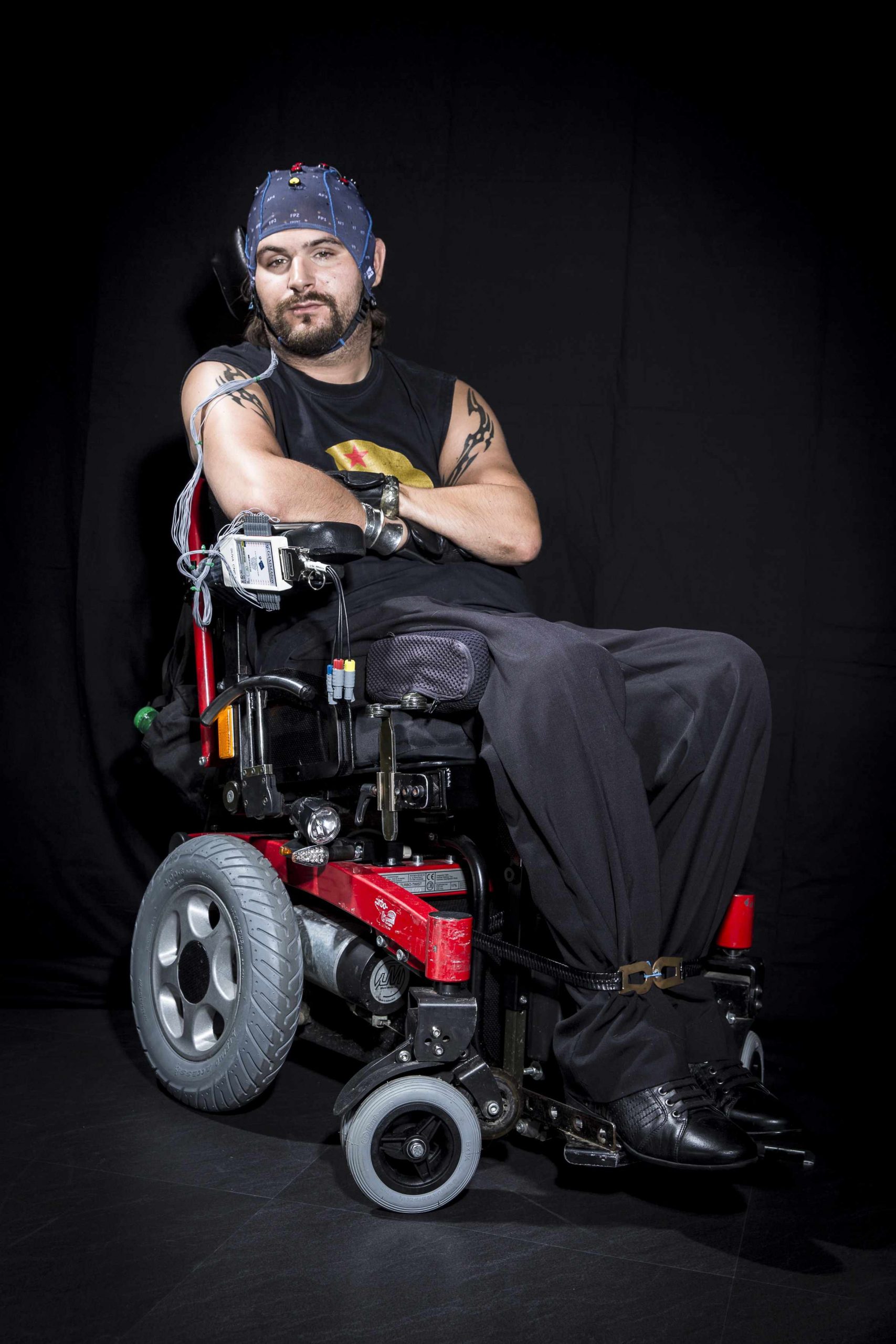
RECORDING EEG & FNIRS SIMULTANEOUSLY
g.USBamp in combination with g.SENSOR fNIRS enables simultaneous recordings of EEG and fNIRS (functional near-infrared spectroscopy) signals. Researchers can capture what might be missed when using only EEG or fNIRS.
g.USBamp users can combine g.GAMMAsys technology to record from active g.LADYbird, active g.SCARABEO or g.SAHARA hybrid electrodes with 8 fNIRS sensors by using g.SENSOR fNIRS.
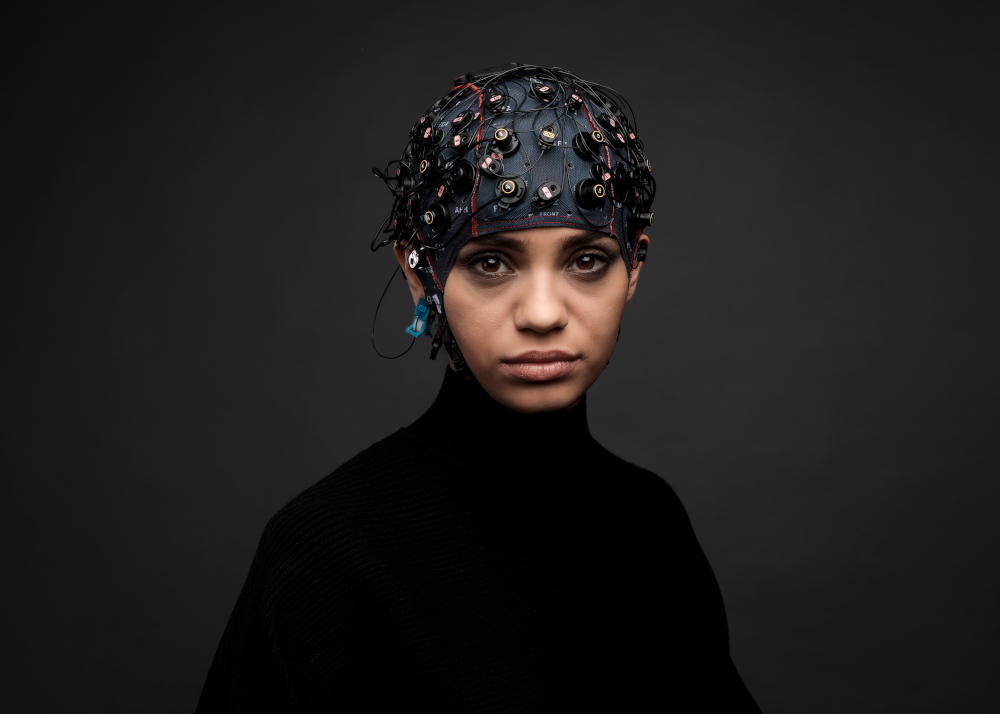
INPUT CHANNEL PROPERTIES
g.USBamp uses wide-range DC-coupled amplifier technology in combination with 24-bit sampling. The result is an input voltage range of +/- 250 mV with a resolution of < 85,7 nV! This means that any physiological signal can be recorded directly, without additional hardware. Neither high electrode offset voltage nor large artifacts resulting from electrical or magnetic stimulation will saturate the amplifier inputs. This feature is an important requisite for various artifact treatment and correction techniques. The use of digital filters avoids hardware-related variations between channels. g.GAMMAsys active electrode system can also be connected directly, as well as all of Body Sensors (e.g. GSR, skin temperature, blood pressure, oxygen saturation, respiration effort and airflow, pulse plethysmography, acceleration, limb movements, snoring sounds, and many more).
ADD MORE CHANNELS OR SPLIT SYSTEMS
To set up a multi-channel system, several g.USBamps can be stacked. Just add another 16 channel g.USBamp amplifier by connecting one more units to the system. The multi-device toolbox from g.HIsys reads in the data of each amplifier into Simulink to perform real-time anaylsis. Each input channel can be used for recording electrophysiological, neurophysiological signals, or external physiological or physical sensors. On the other hand, if you have a 64 channel system consisting of 4 amplifiers, you can split the system to have 4 g.USBamps available.
ACCURACY AND DATA QUALITY
Each of the 16 analog to digital converters operates at 2.4576 MHz. Oversampling 64 times yields the internal sampling rate of 38.400 Hz (per channel and for all channels!). In addition, a powerful floating point Digital Signal Processor performs oversampling and real-time filtering of the biosignal data (between 0 Hz – 2.400 Hz). Therefore, a typical sampling frequency of 256 Hz yields an oversampling rate of 9.600. This results in a very high signal to noise ratio, which is especially critical when recording evoked potentials (EP) in the EEG or identifying small amplitude changes in high-resolution ECG recordings. You are measuring far below the noise-range of conventional amplifiers.
TEST SIGNAL GENERATION AND CALIBRATION
The g.USBamp RESEARCH amplifier can generate an internal sinusoidal-, rectangular-, sawtooth- or white-noise test signal. The amplitude and frequency of the signal can be modified to test the recording and analysis chain. An internal calibration unit periodically detects offset and gain values for each channel and uses these values for automatic internal correction. This technique yields the highest possible accuracy – especially critical for high resolution EEG and source derivation/localization.
RECORDING TMS & TDCS SIMULTANEOUSLY
g.USBamp can be used as EEG amplifier together with g.BSanalyze software while tDCS and TMS are applied. g.BSanalyze offers a post-processing artifact removal algorithm integrated, which robustly eliminates the discharge artifact within a few ms due to tDCS and TMS stimulations.
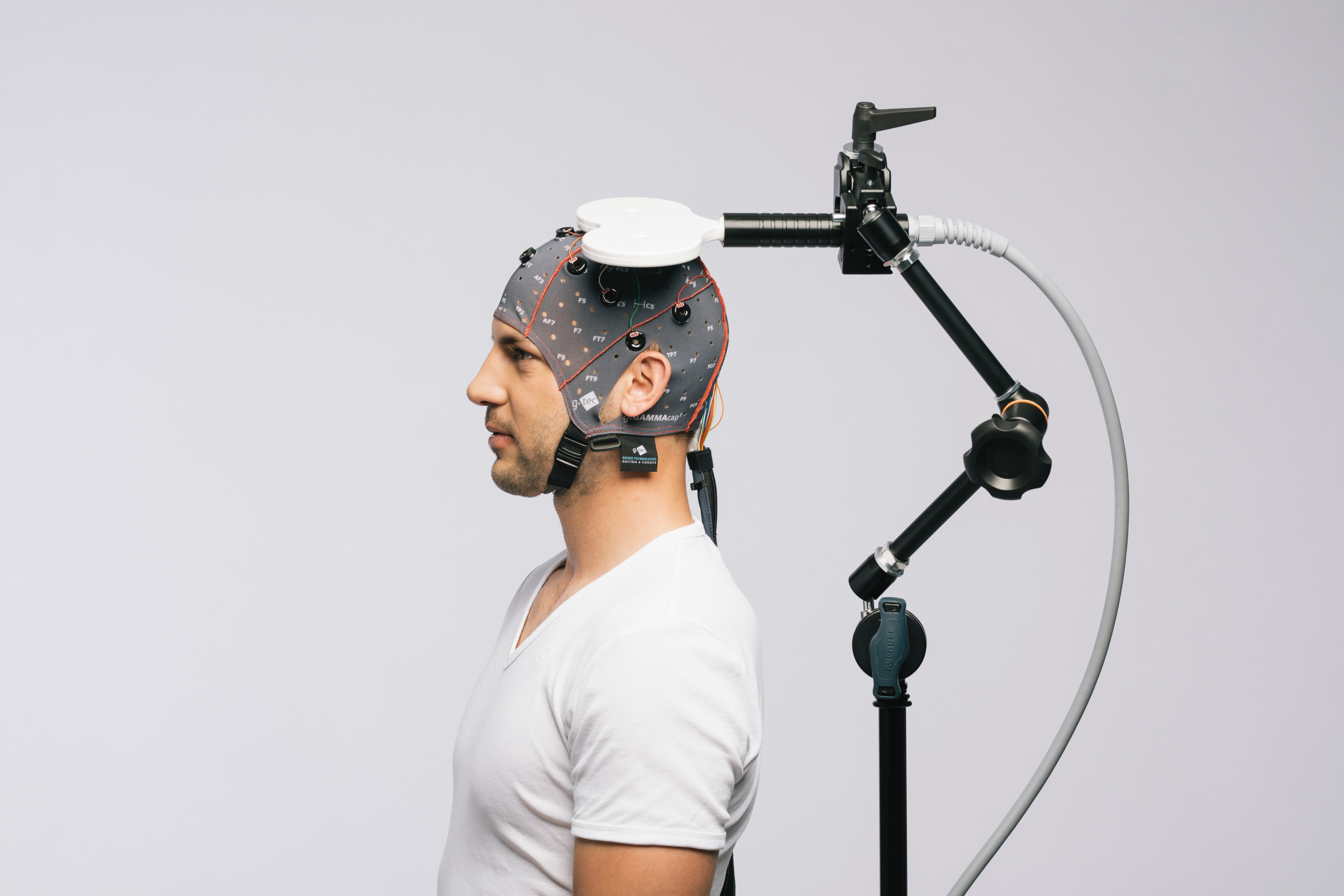
ECOG MEASUREMENTS FOR BRAIN MAPPINGS
Together with g.USBamp RESEARCH, Ad-Tech, PMT, Unique Medical and Cortec grid electrodes can be used to perform ECoG recordings. Additionally, g.HEADstage can be attached to g.USBamp RESEARCH for neural spike recordings.
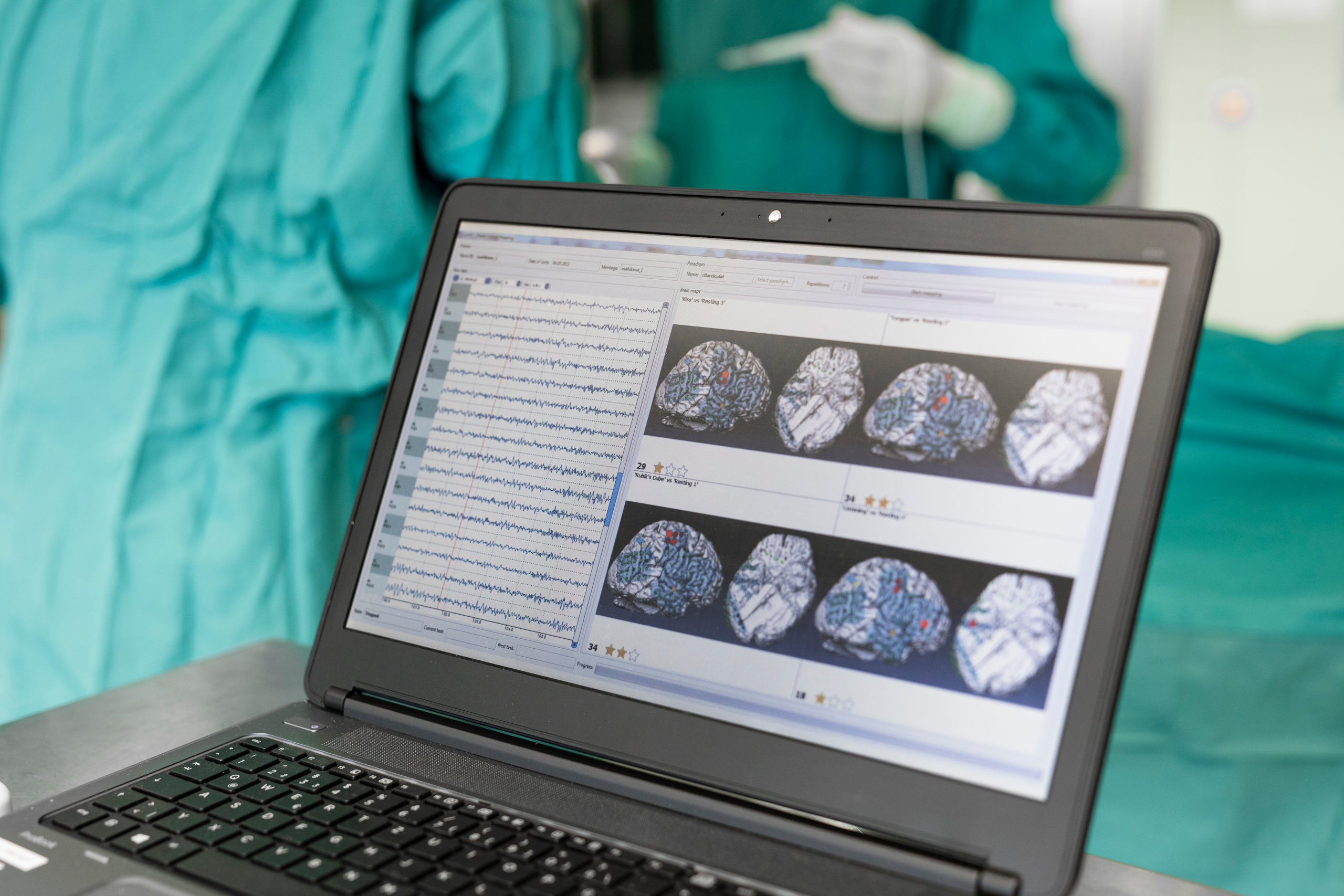
FULL SOFTWARE ENVIRONMENT
There is a a broad software environment for engineers, researchers, scientists, physiologists, and medical staff, as well as software developers or programmers available. From Windows-based recording software to MATLAB/SIMULINK Highspeed Online-Processing environment and device drivers as well as APIs, you will get the appropriate tools for your research.
g.USBamp RESEARCH is also supported by some open source research communities such as OpenViBE and BCI2000, and supports LSL (Lab Streaming Layer) too.

Manufacturer
